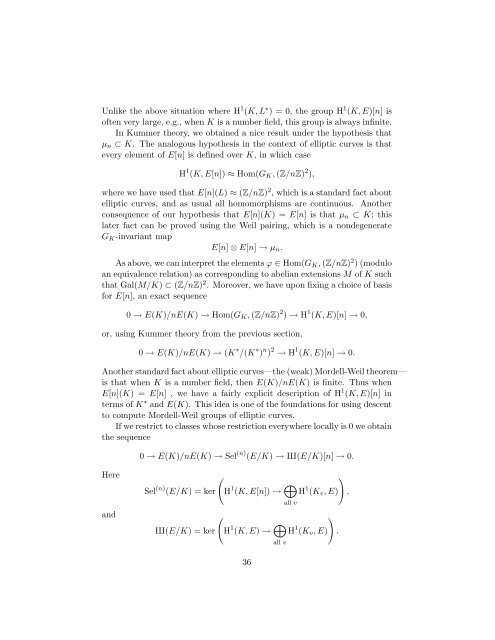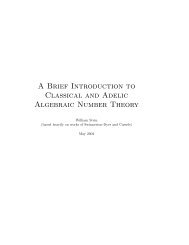A Short Course on Galois Cohomology - William Stein - University of ...
A Short Course on Galois Cohomology - William Stein - University of ...
A Short Course on Galois Cohomology - William Stein - University of ...
Create successful ePaper yourself
Turn your PDF publications into a flip-book with our unique Google optimized e-Paper software.
Unlike the above situati<strong>on</strong> where H 1 (K, L ∗ ) = 0, the group H 1 (K, E)[n] is<br />
<strong>of</strong>ten very large, e.g., when K is a number field, this group is always infinite.<br />
In Kummer theory, we obtained a nice result under the hypothesis that<br />
µn ⊂ K. The analogous hypothesis in the c<strong>on</strong>text <strong>of</strong> elliptic curves is that<br />
every element <strong>of</strong> E[n] is defined over K, in which case<br />
H 1 (K, E[n]) ≈ Hom(GK, (Z/nZ) 2 ),<br />
where we have used that E[n](L) ≈ (Z/nZ) 2 , which is a standard fact about<br />
elliptic curves, and as usual all homomorphisms are c<strong>on</strong>tinuous. Another<br />
c<strong>on</strong>sequence <strong>of</strong> our hypothesis that E[n](K) = E[n] is that µn ⊂ K; this<br />
later fact can be proved using the Weil pairing, which is a n<strong>on</strong>degenerate<br />
GK-invariant map<br />
E[n] ⊗ E[n] → µn.<br />
As above, we can interpret the elements ϕ ∈ Hom(GK, (Z/nZ) 2 ) (modulo<br />
an equivalence relati<strong>on</strong>) as corresp<strong>on</strong>ding to abelian extensi<strong>on</strong>s M <strong>of</strong> K such<br />
that Gal(M/K) ⊂ (Z/nZ) 2 . Moreover, we have up<strong>on</strong> fixing a choice <strong>of</strong> basis<br />
for E[n], an exact sequence<br />
0 → E(K)/nE(K) → Hom(GK, (Z/nZ) 2 ) → H 1 (K, E)[n] → 0,<br />
or, using Kummer theory from the previous secti<strong>on</strong>,<br />
0 → E(K)/nE(K) → (K ∗ /(K ∗ ) n ) 2 → H 1 (K, E)[n] → 0.<br />
Another standard fact about elliptic curves—the (weak) Mordell-Weil theorem—<br />
is that when K is a number field, then E(K)/nE(K) is finite. Thus when<br />
E[n](K) = E[n] , we have a fairly explicit descripti<strong>on</strong> <strong>of</strong> H 1 (K, E)[n] in<br />
terms <strong>of</strong> K ∗ and E(K). This idea is <strong>on</strong>e <strong>of</strong> the foundati<strong>on</strong>s for using descent<br />
to compute Mordell-Weil groups <strong>of</strong> elliptic curves.<br />
If we restrict to classes whose restricti<strong>on</strong> everywhere locally is 0 we obtain<br />
the sequence<br />
Here<br />
and<br />
0 → E(K)/nE(K) → Sel (n) (E/K) → X(E/K)[n] → 0.<br />
Sel (n) <br />
(E/K) = ker H 1 (K, E[n]) → <br />
H 1 <br />
(Kv, E) ,<br />
all v<br />
<br />
X(E/K) = ker H 1 (K, E) → <br />
H 1 <br />
(Kv, E) .<br />
36<br />
all v
















